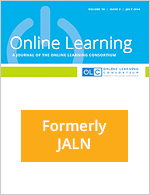Using Asynchronous Audio Feedback to Enhance Teaching Presence and Students’ Sense of Community
This paper reports the findings of a case study in which audio feedback replaced text-based feedback in asynchronous courses. Previous research has demonstrated that participants in online courses can build effective learning communities through text based communication alone. Similarly, it has been demonstrated that instructors for online courses can adequately...

